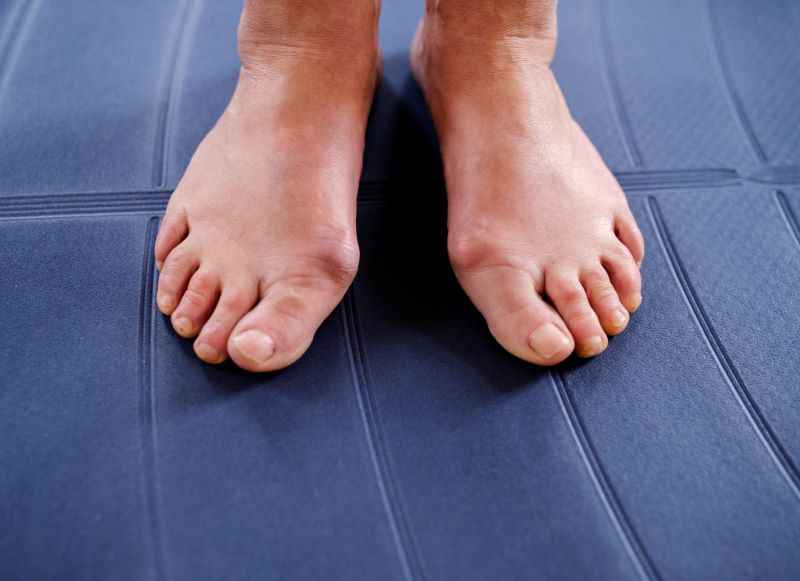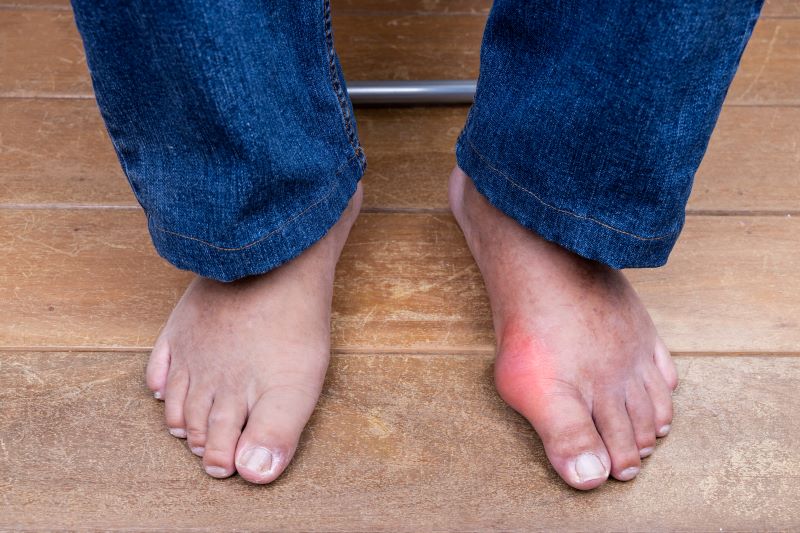You might not know it, but Hallux Valgus is the medical term for bunions. Hallux Valgus is one of the most common foot deformities. According to a review published in the Journal of Foot and Ankle Research, 23% of adults between 18 and 65 years old have hallux valgus. If you are one of these people, you can seek treatment at the Foot & Ankle Specialists of Illinois. In this article, we will discuss the causes and treatment of Hallux Valgus.
 What is Hallux Valgus?
What is Hallux Valgus?
Hallux Valgus is also known as a bunion. It is a progressive foot deformity that appears as a bony bump on the joint at the base of your big toe. Bunions can form on one or both feet. Without treatment, bunions will worsen over time. But if your Hallux Valgus is correctly diagnosed and treated, the symptoms will vastly improve.
Hallux Valgus is not to be confused with Hallux Rigidus, which is when you struggle to move your big toe and feel stiffness and pain.
Hallux Valgus Symptoms
Typically, your bunion will be red, swollen, and painful. Some other symptoms of Hallux Valgus include:
- Inability to bend the big toe
- Pain or burning when you try to bend it
- Numbness in the big toe
- Difficulty wearing normal shoes
- Corns or calluses
- Hammertoes
Hallux Valgus Causes
There are several causes for Hallux Valgus. Bunions happen gradually over time. Narrow shoes and standing for long periods of time can worsen the pain of bunions even worse.
People in certain professions who stand for long parts of the day, like nurses, teachers, ballet dancers, and waiters, are oftentimes more likely to develop bunions. Your foot mechanics, or the pressure from the way you walk, and foot structure, the shape of your foot, can also cause bunions. Bunions are also more common in women than in men.
You may be more likely to get bunions if you have a family history of Hallux Valgus, foot structure problems, foot injuries, and inflammatory diseases like rheumatoid arthritis.
The Different Types of Hallux Valgus
There are different types of Hallux Valgus:
- Congenital Hallux Valgus: Some babies are born with bunions.
- Juvenile or Adolescent Hallux Valgus: Some tweens and teens (between the ages of 10 and 15) can develop bunions.

Hallux Valgus Treatment
Once your x-rays have shown that you have Hallux Valgus, there are several options for non-surgical and surgical treatments to help alleviate the pain and delay the progression of the bunion. Unfortunately, Hallux Valgus doesn’t go away on its own. You will need treatment, which typically focuses on relieving the symptoms.
Changing Footwear
The first step is to change your footwear. Switch to shoes with wide, deep toe boxes that take pressure off your toes. If you don’t want to buy new shoes, you might be able to use a stretching device to widen the shoes already in your closet.
Bunion Pads and Taping
There are over-the-counter bunion pads and other products that can cushion the area and ease your pain. You can also try medical tape to keep your foot in the right position.
Rest, Ice, and Elevation
Try rest, ice, and elevation to ease your bunion pain. This is a simple yet effective method of treating foot ailments like hallux valgus.
Custom Orthotics
Custom orthotics are specially made for your feet. We often recommend custom orthotics to balance the foot’s biomechanics and allow your joints and osseous structures to function more appropriately. This slows the progression of the bunion deformity.
Pain Relievers
For temporary relief, you can take anti-inflammatory medication. NSAID medication can help reduce both swelling and pain and work quickly.
Injections
A corticosteroid injection might be recommended to help shrink the bursa and provide temporary relief.
Physical Therapy
In some cases, physical therapy, massage, and ultrasound therapy can break up the soft-tissue adhesions to reduce pain and inflammation. There are also exercises that can increase muscle strength around the bunion.
Maintain a Healthy Weight
Your feet work hard to support your body and help you move everywhere you go. Your weight impacts your overall foot health. Maintaining a healthy weight is one way to avoid developing bunions.
When to Consider Surgery for Hallux Valgus
Most of the time, our team can help you manage bunion pain without surgery. But if other types of treatment like bunion pads and better-fitting shoes have not worked, then we might recommend foot surgery. Surgery is the only way to permanently remove a bunion.
There are several different options available when it comes to surgical treatment for bunions. Generally, the procedure is designed to restore the alignment of the first metatarsal in all three planes, excise the painful bony bump as necessary, and restore the correct soft tissue balance.
Signs That It’s Time to Treat Bunion Pain
Some bunions are mild and don’t require treatment. But there are several signs that you have Hallux Valgus and need to seek treatment, including:
- You are reducing your normal activities due to pain
- You can’t find comfortable shoes to wear
- You have arthritic changes in the joint that are visible on an x-ray
Bunion Treatment at Foot & Ankle Specialists of Illinois
At Foot & Ankle Specialists of Illinois, we specialize in bunion therapy and treatment. We work with you to create a plan to diagnose and fix bunions. The recovery period for your surgery will depend on the surgical procedure that we perform. Your surgeon at FASI will take several factors into account when creating your bunion treatment plan, including your age, activity level, lifestyle, and the severity of your case of Hallux Valgus. Our goal is to help you achieve healthy feet so you can maintain a healthy, active lifestyle.
 Get Treatment for Hallux Valgus at Foot & Ankle Specialists of Illinois
Get Treatment for Hallux Valgus at Foot & Ankle Specialists of Illinois
If your daily life is negatively impacted by bunions, take your first step toward relief with us. Healthy feet are important for a healthy body and a healthy life. If you think you might have Hallux Valgus, get your treatment at Foot & Ankle Specialists of Illinois. Book an appointment today!

